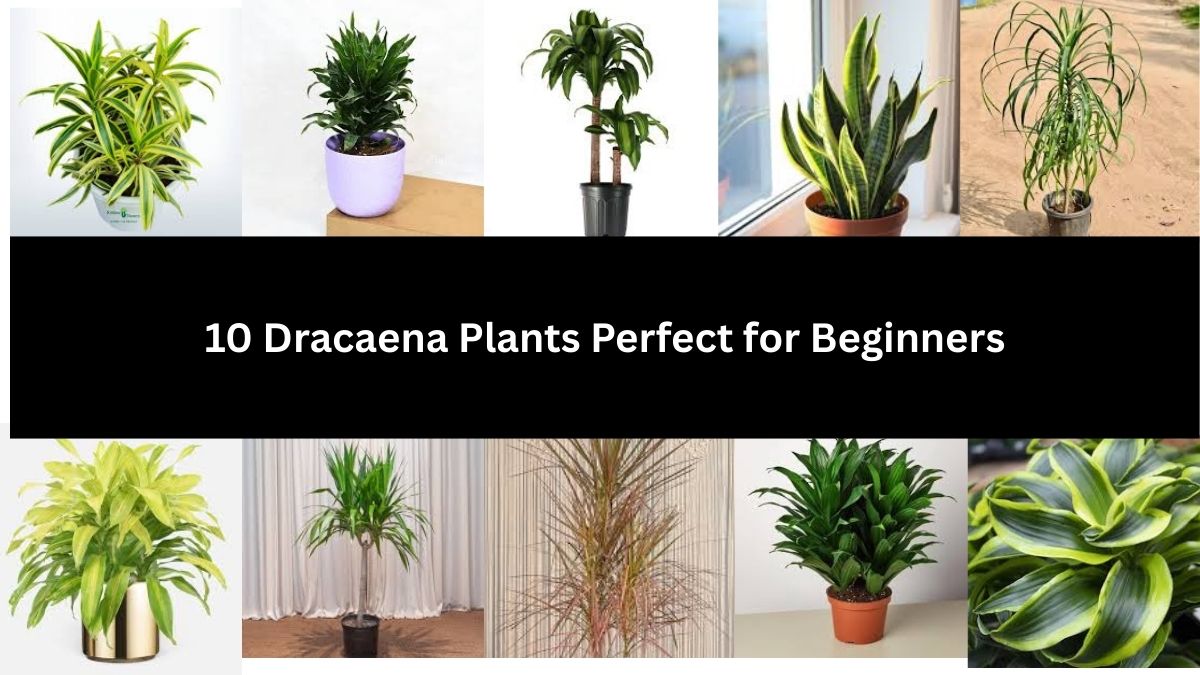Dracaena plants have long held the title of “beginner’s best friend” in the world of houseplants—and for good reason. These tropical beauties are prized for their exceptional resilience, attractive foliage, and minimal care requirements. Whether you’re new to indoor gardening or simply seeking low-effort greenery to brighten your home or workspace, Dracaenas are a perfect starting point.
With a wide range of shapes, sizes, and leaf colors, Dracaena plants offer both visual impact and functional benefits like air purification. From compact tabletop varieties to tall architectural specimens, there’s a Dracaena suited to every aesthetic and space.

Quick Summary
| Feature | Details |
|---|---|
| Ideal For | Beginners, busy individuals, low-light homes |
| Key Benefits | Air purification, easy care, wide variety |
| Light Requirements | Bright to low indirect light |
| Watering Needs | When top inch of soil is dry (every 1–2 weeks typically) |
| Toxicity | Mildly toxic to pets |
| Difficulty Level | Very easy |
| Official Plant Info | South African National Biodiversity Institute |
Why Choose Dracaena?
1. Resilient and Forgiving
Dracaenas are extremely tolerant of neglect. They can withstand missed waterings, inconsistent lighting, and even occasional repotting delays. This makes them ideal for plant parents who are still mastering the basics of plant care.
2. Visually Versatile
Dracaena species come in a stunning array of appearances. Some have upright stems with narrow, sword-like leaves while others feature broader, variegated foliage. Leaf colors range from deep green to vibrant yellow or red-tinged edges.
3. Excellent Air Purifiers
These plants are natural detoxifiers. Studies, including those by NASA, have shown that Dracaenas remove toxins like benzene, formaldehyde, and trichloroethylene from indoor environments, improving air quality.
Top 10 Dracaena Varieties for Beginners
1. Dracaena Marginata (Dragon Tree)
-
Known for: Spiky green leaves edged with red
-
Size: Grows up to 8 feet indoors
-
Ideal for: Bright to medium-light rooms
-
Bonus: Low water needs and minimal maintenance
2. Dracaena Fragrans (Corn Plant)
-
Appearance: Broad green leaves, similar to corn stalks
-
Growth: Slow-growing, tree-like form
-
Best use: Living rooms and offices with moderate light
-
Health benefit: Excellent air purifier
3. Dracaena Reflexa (Song of India)
-
Appearance: Yellow-edged green leaves in whorled clusters
-
Environment: Bright, indirect light for best color
-
Feature: Compact and bushy, ideal for shelves or desks
4. Dracaena Deremensis ‘Janet Craig’
-
Look: Dark green, glossy foliage
-
Light: Low to medium indirect light
-
Strength: Thrives in low-light environments, grows tall and elegant
5. Dracaena Surculosa (Gold Dust Dracaena)
-
Traits: Speckled leaves resembling gold dust
-
Size: Compact and decorative
-
Use: Desks, corners, or entryways
6. Dracaena Compacta
-
Appearance: Dark green leaves in tight rosettes
-
Design: Perfect for minimalist interiors
-
Maintenance: Water sparingly; prefers moderate light
7. Dracaena Warneckii
-
Foliage: White or light green striped leaves
-
Benefit: Brightens darker corners with variegated leaves
-
Feature: Resilient in low-light environments
8. Dracaena Sanderiana (Lucky Bamboo)
-
Format: Can grow in water or soil
-
Cultural significance: Symbol of good luck
-
Ideal for: Desktops, small counters, and gifts
9. Dracaena Cinnabari (Dragon Blood Tree)
-
Exotic appeal: Umbrella-shaped canopy, red sap
-
Conditions: Prefers bright light and well-draining soil
-
Use: Conversation starter, collectors’ item
10. Dracaena Arborea
-
Shape: Tree-like structure with long, narrow leaves
-
Placement: Large indoor spaces or entryways
-
Impact: Bold and sculptural for modern homes
Dracaena Care Requirements Overview
| Care Aspect | Recommended Practice |
|---|---|
| Light | Bright, indirect light preferred |
| Watering | When top inch of soil is dry; every 1–2 weeks |
| Soil | Well-draining potting mix |
| Humidity | Average household levels (40–50%); mist occasionally |
| Temperature | 65–75°F (18–24°C); avoid cold drafts and direct heat |
| Fertilizing | Monthly in growing season (spring–summer) |
| Repotting | Every 2–3 years or when root-bound |
Troubleshooting Common Dracaena Issues
| Symptom | Likely Cause | Solution |
|---|---|---|
| Brown leaf tips | Overwatering, fluoride sensitivity | Use filtered water, reduce watering |
| Yellowing leaves | Overwatering or natural aging | Trim yellow leaves, let soil dry |
| Pale leaves or stretching | Too little light | Move to brighter indirect light |
Benefits of Growing Dracaena Plants
-
Improved Indoor Air Quality: Filters toxins and pollutants
-
Low Maintenance: Excellent for forgetful waterers
-
Decor Versatility: Fits modern, traditional, and eclectic styles
-
Educational Value: Teaches foundational plant care skills
-
Stress Reduction: Greenery is proven to enhance mental well-being
Frequently Asked Questions
Q: How often should I water my Dracaena?
A: Only water when the top inch of soil feels dry—generally every 1–2 weeks depending on humidity and temperature.
Q: Can Dracaenas survive in low-light conditions?
A: Yes, many varieties like ‘Janet Craig’ and ‘Warneckii’ do well in low light, although growth may slow.
Q: Are Dracaena plants safe for pets?
A: No. Dracaenas are mildly toxic to cats and dogs if ingested, so it’s best to keep them out of reach.
Q: Why are my Dracaena’s leaf tips turning brown?
A: This can be caused by fluoride in tap water, low humidity, or overwatering. Use filtered water and mist leaves if necessary.
Q: Do Dracaenas need to be fertilized?
A: Yes, but only during the growing season (spring and summer) with a diluted liquid fertilizer.
Conclusion
Dracaena plants are the ideal choice for new plant owners and seasoned gardeners alike. Their unmatched combination of elegance, ease of care, and health benefits makes them a top-tier option for indoor gardening. Whether you want a statement piece or a compact desk companion, there’s a Dracaena that fits your space and lifestyle.
By starting your plant journey with one of these resilient, visually stunning varieties, you’re setting yourself up for long-term success—and perhaps even discovering a lifelong passion for indoor gardening.
Click here to know more